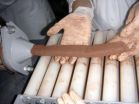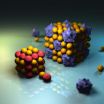(Press-News.org) Researchers at the University of Jaen (Spain) have mixed waste from the paper industry with ceramic material used in the construction industry. The result is a brick that has low thermal conductivity meaning it acts as a good insulator. However, its mechanical resistance still requires improvement.
"The use of paper industry waste could bring about economic and environmental benefits as it means that material considered as waste can be reused as raw material." – This is one of the conclusions of the study developed by researchers at the Upper Polytechnic School of Linares (University of Jaen), which has been published in the 'Fuel Processing Technology' journal.
The scientists collected cellulous waste from a paper factory (recycled waste in this case) along with sludge from the purification of its waste water. In their laboratory they then mixed this material with clay used in construction and passed the mixture through a pressure and extrusion machine to obtain bricks.
"Adding waste means that the end product has low thermal conductivity and is therefore a good insulator," explains Carmen Martínez, researcher at the University of Jaen. "In addition to the resulting benefit of using these bricks instead of their traditional counterparts made of traditional raw materials."
VIDEO:
This video explains the process of using paper waste to make bricks.
Click here for more information.
Another of the advantages of adding waste to the brick prototypes is that they provide energy due to their organic material content. This could help to reduce fuel consumption and kiln time required for brick production.
At the moment the prototype's dimensions are small (3 x 1 x 6 cm). But the team has already tested larger bricks and the results are similar. "On the whole, this technique could bring about a saving in energy and raw materials for brick factories along with environmental benefits from the use of waste that is initially discarded," adds Martínez.
The researcher recognises, however, that the 'Achilles heel' of these bricks is their lower mechanical resistance compared to traditional bricks, although this parameter is above the legal minimum. There are still a few problems to solve in the adherence and shaping of those pieces that have high percentages of paper waste.
The team continues in their search for the happy medium between sustainability and material resistance and is still researching the advantages of adding other products, such as sludge from water treatment plants or residues from the beer, olive and biodiesel industries.
In the 'Fuel Processing Technology' journal itself, the researchers have published another study confirming that biodiesel waste can be used for brick manufacture, thus increasing insulation capacity by 40%.
INFORMATION:
References:
Carmen Martínez, Teresa Cotes, Francisco A. Corpas. "Recovering wastes from the paper industry: Development of ceramic materials". D. Eliche-Quesada, S. Martínez-Martínez, L. Pérez-Villarejo, F. J. Iglesias-Godino, C. Martínez-García, F.A. Corpas-Iglesias. "Valorizationof biodiesel production residues in making porous clay brick". Fuel Processing Technology 103, 2012. Doi: 10.1016/j.fuproc.2011.10.017 and 10.1016/j.fuproc.2011.11.013.
Paper waste used to make bricks
2012-12-19
ELSE PRESS RELEASES FROM THIS DATE:
New dynamic dual-core optical fiber enhances data routes on information superhighway
2012-12-19
Optical fibers –the backbone of the Internet–carry movies, messages, and music at the speed of light. But for all their efficiency, these ultrathin strands of pristine glass must connect to sluggish signal switches, routers, and buffers in order to transmit data. Hoping to do away with these information speed bumps, researchers have developed a new, dual-core optical fiber that can perform the same functions just by applying a miniscule amount of mechanical pressure.
These new nanomechanical fibers, which have their light-carrying cores suspended less than 1 micrometer ...
Cholesterol helps regulate key signaling proteins in the cell
2012-12-19
Cholesterol plays a key role in regulating proteins involved in cell signaling and may be important to many other cell processes, an international team of researchers has found.
The results of their study are reported in the journal Nature Communications.
Cholesterol's role in heart disease has given it a bad reputation. But inside the thin membrane of a cell, the tight regulation of cholesterol at high levels (30 to 40 percent) suggests that it plays an important role in cellular processes, says Wonhwa Cho, professor of chemistry at the University of Illinois at Chicago ...
Synthetic and biological nanoparticles combined to produce new metamaterials
2012-12-19
Scientists from Aalto University, Finland, have succeeded in organising virus particles, protein cages and nanoparticles into crystalline materials. These nanomaterials studied by the Finnish research group are important for applications in sensing, optics, electronics and drug delivery.
Layer structures, or superlattices, of crystalline nanoparticles have been extensively studied in recent years. The research develops hierarchically structured nanomaterials with tuneable optical, magnetic, electronic and catalytic properties.
Such biohybrid superlattices of nanoparticles ...
Community togetherness plays vital role in coping with tragedies
2012-12-19
Community solidarity and support have remarkable benefits for people coping with traumatic mass shootings, according to an American-Finnish research study recently published by the University of Turku.
James Hawdon and John Ryan, both professors of sociology at Virginia Tech, with Finnish researchers Atte Oksanen and Pekka Räsänen, investigated the responses of four communities that suffered from similar tragedies in the United States and Finland.
People in all four communities expressed their need for belonging after the shootings, and this solidarity appeared to ...
Johns Hopkins malpractice study: Surgical 'never events' occur at least 4,000 times per year
2012-12-19
After a cautious and rigorous analysis of national malpractice claims, Johns Hopkins patient safety researchers estimate that a surgeon in the United States leaves a foreign object such as a sponge or a towel inside a patient's body after an operation 39 times a week, performs the wrong procedure on a patient 20 times a week and operates on the wrong body site 20 times a week.
The researchers, reporting online in the journal Surgery, say they estimate that 80,000 of these so-called "never events" occurred in American hospitals between 1990 and 2010 — and believe their ...
Helping the nose know
2012-12-19
More than a century after it was first identified, Harvard scientists are shedding new light on a little-understood neural feedback mechanism that may play a key role in how the olfactory system works in the brain.
As described in a December 19 paper in Neuron by Venkatesh Murthy, Professor of Molecular and Cellular Biology, researchers have, for the first time, described how that feedback mechanism works by identifying where the signals go, and which type of neurons receive them. Three scientists from the Murthy lab were involved in the work: Foivos Markopoulos, Dan ...
Men with fibromyalgia often go undiagnosed, Mayo Clinic study suggests
2012-12-19
ROCHESTER, Minn. -- Fibromyalgia is a complex illness to diagnose and to treat. There is not yet a diagnostic test to establish that someone has it, there is no cure and many fibromyalgia symptoms -- pain, fatigue, problems sleeping and memory and mood issues -- can overlap with or get mistaken for other conditions. A new Mayo Clinic study suggests that many people who have fibromyalgia, especially men, are going undiagnosed. The findings appear in the online edition of the journal Arthritis Care & Research.
More research is needed, particularly on why men who reported ...
High-throughput sequencing shows potentially hundreds of gene mutations related to autism
2012-12-19
Genomic technology has revolutionized gene discovery and disease understanding in autism, according to an article published in the December 20 issue of the journal Neuron.
The paper highlights the impact of a genomic technology called high-throughput sequencing (HTS) in discovering numerous new genes that are associated with autism spectrum disorder (ASD).
"These new discoveries using HTS confirm that the genetic origins of autism are far more complex than previously believed," said Joseph D. Buxbaum, PhD, Director of the Seaver Autism Center at the Icahn School of ...
Auto-immune disease: The viral route is confirmed
2012-12-19
Why would our immune system turn against our own cells? This is the question that the combined Inserm/CNRS/ Pierre and Marie Curie University/Association Institut de Myologie have strived to answer in their "Therapies for diseases of striated muscle", concentrating in particular on the auto-immune disease known as myasthenia gravis. Through the project known as FIGHT-MG (Fight Myasthenia Gravis), financed by the European Commission and coordinated by Inserm, Sonia Berrih-Aknin and Rozen Le Panse have contributed proof of the concept that a molecule imitating a virus may ...
Toward a pill to enable celiac patients to eat foods containing gluten
2012-12-19
Scientists are reporting an advance toward development of a pill that could become celiac disease's counterpart to the lactase pills that people with lactose intolerance can take to eat dairy products without risking digestive upsets. They describe the approach, which involves an enzyme that breaks down the gluten that causes celiac symptoms, in the Journal of the American Chemical Society.
Justin Siegel, Ingrid Swanson Pultz and colleagues explain that celiac disease is an autoimmune disorder in which the gluten in wheat, rye or barley products causes inflammation in ...


